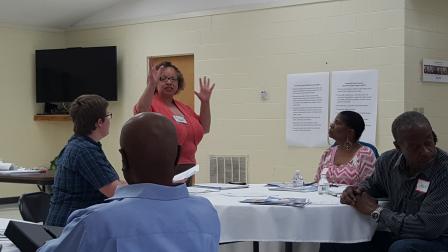Community-Port Collaboration: Training Modules and Resources
 This page provides training materials and other resources to help facilitate community-port collaboration including training modules specific to the Community-Port Collaboration Toolkit.
This page provides training materials and other resources to help facilitate community-port collaboration including training modules specific to the Community-Port Collaboration Toolkit.
On this page:
- Community-Port Collaboration Toolkit Training
- Pilot Projects Lessons Learned Training
- Community Benefits Agreement Training
- Community Resource Publications
Free Viewers are available for viewing documents on this webpage.
Community-Port Collaboration Toolkit Training
Below are three training modules for the Community-Port Collaboration Toolkit designed to introduce each tool with options for more or less detail depending on the allotted time for training as outlined in the Training Facilitators Resource.
- Training Facilitators Resource for Community-Port Collaboration Toolkit (WORD)(8 pp, 668 K, July 2020)
- Training Module 1: Ports Primer for Communities (POWERPOINT)(41 pp, 2 MB, July 2020)
- Training Module 2: Community Action Roadmap (POWERPOINT)(27 pp, 7 MB, July 2020)
- Training Module 3: Environmental Justice Primer for Ports (POWERPOINT)(45 pp, 5 MB, July 2020)
Pilot Projects Lessons Learned Training
This training module provides a look at some of the key lessons learned from the pilots.
Community Benefits Agreement Training
Community benefits agreement (CBA) training seeks to help participants learn the basics of CBAs, develop a shared language for communicating community concerns, and engage in dialogue around lessons learned from other similar CBA processes. Below are the training CBA training materials.
- Delivering Training on Community Benefits Agreements (WORD)(7 pp, 664 K, July 2020)
- Community Benefits Agreement Training (POWERPOINT)(25 pp, 9 MB, July 2020)
Community Resource Publications
The Community Action Roadmap: Resources webpage contains a table that has resources on additional subjects that may be of interest to near-port communities including:
- Community Action for a Renewed Environment (CARE) Roadmap
- Strategies for advancing Smart Growth, environmental justice and equitable development;
- Developing effective coalitions;
- Collaborative problem-solving;
- Local use planning;
- Environmental justice best practices for local governments;
- Public participation; and
- Sustainability workbook for environmental justice and equitable development.



